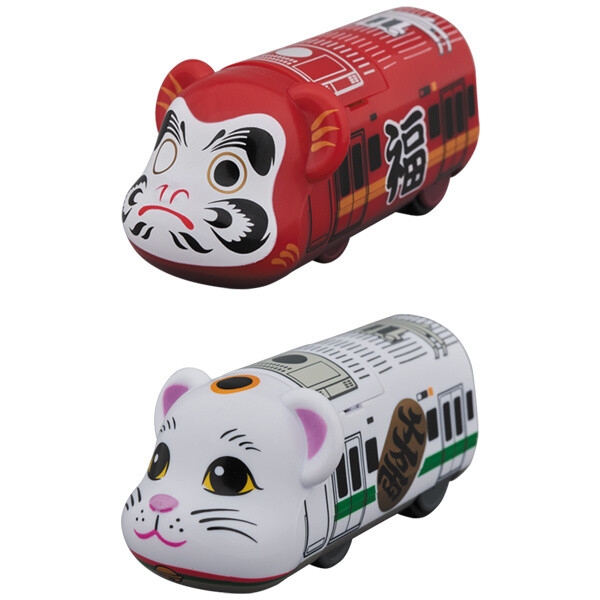 Daruma and Manekineko Trains - BE@RBRICK
Daruma and Manekineko Trains - BE@RBRICK
Along the lines of the cat-shaped NY@BRICK and rabbit-shaped R@BBRICK lines, Medicom Toy introduced a new BE@RBRICK variant with Trains. A relatively new line, the BE@BRICK Trains primarily represent popular Japanese train models. However, the first entries incorporated images from Japanese culture for added whimsy. Simply titled "BE@RBRICK Train," the debut Train figures invoke good luck for all BE@RBRICK figure passengers.
BE@RBRICK Train and Medicom Toy Collaboration Background
Medicom Toy initially included trains as incorporated imagery on standard BE@RBRICK shaped figures. Starting in 2018, the company began producing a train-shaped BE@RBRICK line depicting Japanese train lines.
Collaboration Planning and Launch History
The first BE@RBRICK Train figures depicted train car style, bear-eared figures with Daruma doll and Maneki-neko designs. The figures came out in March 2018. Also in 2018, Medicom Toy released a BE@RBRICK multi-car train figure in the design of Hanshin Jet Silver 5700. The three-part figure can seat six BE@RBRICK standard size figures inside. It also included a standard size conductor BE@RBRICK figure. That year also saw the release of single-car Train figures modeled on the Keikyu 2100 series and Seibu 40000 series trains. In 2019, Medicom Toy added the Tokyo Metro Ginza Line and the Odakyu Romance Car to the lineup.
BE@RBRICK Train
These wheeled, train car-shaped figures from BE@RBRICK bring a new level of fun to the collectible. This set contains two distinct designs: a Daruma doll and a Maneki-neko. Each Train features a front section shaped like the BE@RBRICK head.
The Daruma-inspired Train figure features a partially completed doll face on the front. The singular finished eye represents a goal in-progress to serve as motivation. Surrounding the eyes are the crane and tortoise-shaped eyebrows and mustache, representing longevity. Along the sides, the figure features a realistic set of train windows and doors accented with an orange stripe. The kanji for "Fortune" adorns the blank space between doors.
The Maneki-neko Train follows a similar design on the sides. Its defining symbol is the koban coin, marked with the phrase "sen man ryou," meaning 10 million gold coins. The face features an open-eyed design with six whiskers and a pink nose and mouth. Both figures can "seat" standard size BE@RBRICK figures. A detachable component on the train roof decorated top opens up to a hollow compartment.
- Product Name: BE@RBRICK Train
- Brand: BE@RBRICK
- Manufacturer: Medicom Toy
- Dimensions (Approx.): 30 x 30 x 70mm | 1.2" x 1.2" x 2.8"

Daruma Background
The Daruma doll is a traditional Japanese doll modeled after Bodhidharma, the founder of Zen Buddhism. Its basic design features many symbolic elements but represents good luck overall in Japanese culture.
Daruma Background: History
Many believe the Daruma doll originated in the Gunma prefecture area around the 18th century. Legend states that a local priest created the Daruma to answer parishioners' requests for good luck talismans. The temple created a Daruma mold for visitors to create their own paper-mâché doll. Each aspect of the doll's design is rooted in symbolism. The hollow body with a weighted base is designed to return to an upright position after being knocked down. Red is used as the main color both as a reference to traditional priest robes in Japan and the color's association with luck. The blank, asymmetrical eyes serve as a reminder and motivation to finish a goal. After purchasing the doll, owners fill in one of the eyes when beginning a task and the second after finishing it. The facial hair represents animals associated with longevity: the tortoise and the crane.
Daruma Background: Today
The Daruma doll has many associated customs and references today. At the end of the year, parishioners bring the Daruma they purchased back to the temple for a mass burning. Daruma are now sold in colors other than red, each representing luck in different fields. In popular culture, Daruma dolls are mentioned in many children's games. For example, "Daruma-san ga Koronda" is a tag-style game similar to Red Light/Green Light. Daruma are also referenced in common phrases, such as the Japanese word for snowman, yukidaruma.
Maneki-neko Background
The Maneki-neko, or beckoning cat, is a common Japanese figurine used as a talisman for good luck. These figures are often displayed at a business entrance to beckon customers and therefore wealth.
Maneki-neko Background: History
Most believe that the Maneki-neko originated during the late Edo period either in Tokyo or Kyoto. The earliest records of Maneki-neko, a ukiyo-e painting and chronology book of Edo, date back to 1852. Newspaper articles and advertisements indicate the figure's popularity by 1902. Due to the cat figure's raised paw, many believe its origins relate to superstitions related to a cat washing its face. The Japanese superstition states that a cat washing its face signals an incoming visitor. A Chinese proverb states that a bathing cat means "patrons will come." One folktale features a grateful stray cat drawing in customers to reward an impoverished small business owner for their charity.
Maneki-neko Background: Today
The Maneki-neko figure has new functions and features related to modern influences. While the traditional cat is a calico Japanese bobtail, influences from Feng Shui created alternate versions of the figure. For example, white figures represent positivity, black invites protection, and red guarantees good health. More factors like which paw is raised, the accompanying accessory, and facial expression lend to more luck customization. Maneki-neko is also a common figure in the media such as the inspiration for one of Pokemon's most famous creatures, Meowth.